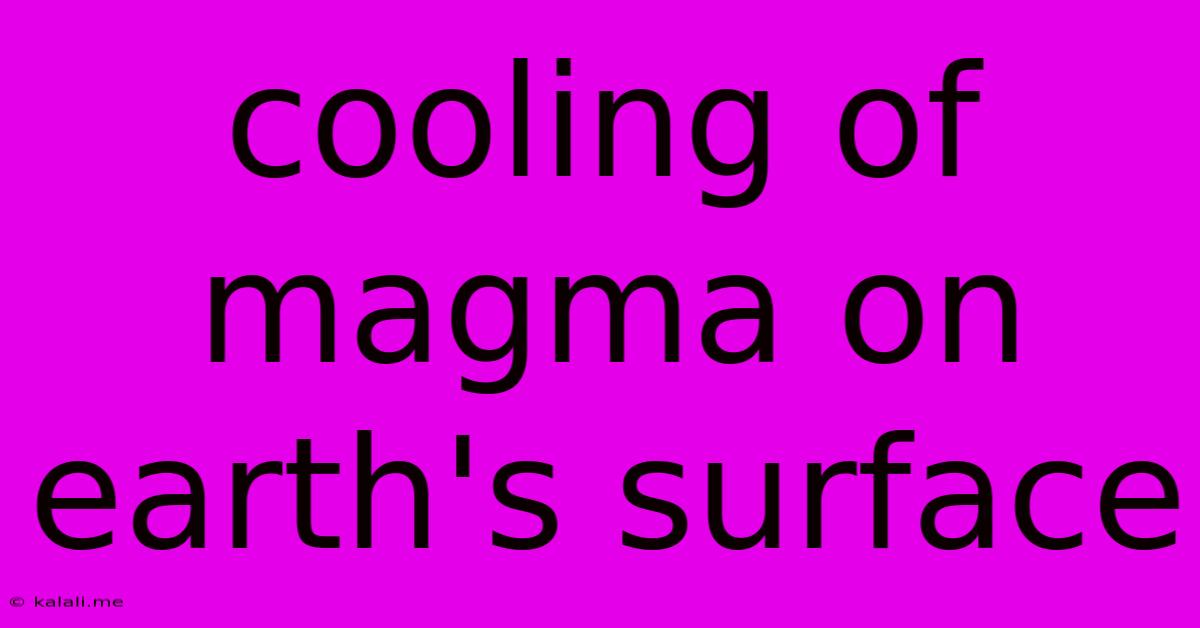Cooling Of Magma On Earth's Surface
Kalali
Jun 14, 2025 · 3 min read

Table of Contents
The Cooling of Magma: From Molten Rock to Solid Stone
The Earth's fiery heart, a churning mass of molten rock and metal, occasionally erupts onto the surface, unleashing its power in the form of volcanic eruptions. This molten rock, known as magma when underground and lava once it reaches the surface, doesn't remain a fiery liquid forever. Understanding how magma cools and solidifies is key to understanding the formation of igneous rocks, a fundamental process in shaping our planet’s geology. This article will explore the various factors that influence the cooling process and the resulting rock formations.
Factors Affecting Magma Cooling Rates
The rate at which magma cools significantly impacts the resulting rock's texture and mineral composition. Several key factors contribute to this variability:
-
Volume of Magma: Larger volumes of magma take longer to cool than smaller volumes. A massive lava flow will cool slowly from the outside in, allowing ample time for large crystals to grow. Conversely, smaller eruptions, like those from cinder cones, cool rapidly, often resulting in fine-grained rocks.
-
Depth of Intrusion: Magma that intrudes into the Earth's crust at shallow depths cools faster than magma that intrudes at greater depths. The surrounding cooler rocks act as a heat sink, accelerating the cooling process at shallower levels. This is why intrusive rocks, formed beneath the surface, often exhibit coarser textures compared to extrusive rocks formed at the surface.
-
Presence of Water: Water acts as a powerful cooling agent. Volcanic eruptions near bodies of water, or those involving water interaction, will cool considerably faster due to the high heat capacity of water and its ability to absorb heat effectively. This often leads to the formation of glassy or fine-grained textures.
-
Insulation: The presence of insulating materials, such as volcanic ash or other rock fragments, can slow down the cooling process. This is because the insulating materials prevent the rapid escape of heat from the magma.
-
Convection and Conduction: Heat transfer mechanisms also play a crucial role. Convection, the movement of heated material, and conduction, the transfer of heat through direct contact, both affect the rate of cooling. The efficiency of these processes influences the overall cooling time and the texture of the resulting rock.
From Magma to Igneous Rocks: A Textural Transformation
The cooling rate directly impacts the size of the crystals that form within the solidifying magma. This ultimately determines the texture of the resulting igneous rock:
-
Intrusive Rocks (Plutonic Rocks): These rocks form from magma that cools slowly beneath the Earth's surface. The slow cooling allows ample time for large crystals to grow, resulting in coarse-grained textures, as seen in granite and gabbro. Examples include batholiths, laccoliths, and sills.
-
Extrusive Rocks (Volcanic Rocks): These rocks form from lava that cools rapidly at the Earth's surface. The rapid cooling prevents the formation of large crystals, resulting in fine-grained textures, as observed in basalt and rhyolite. Rapid cooling can also result in glassy textures, such as obsidian, where crystals don't have time to form at all. Pumice, with its vesicular (holey) texture, also results from rapid cooling and the escape of gases.
The Significance of Magma Cooling
Understanding magma cooling is vital for comprehending various geological processes. It helps explain:
-
Formation of different igneous rock types: The diversity in igneous rock textures and compositions is directly linked to variations in magma cooling rates and environments.
-
Volcanic hazards: Knowledge of cooling rates can contribute to better predictions of volcanic eruptions and their potential impacts.
-
Plate tectonics: The formation of igneous rocks is closely tied to plate tectonic movements and the creation and destruction of crust.
-
Mineral resource formation: Many valuable mineral deposits are associated with igneous rocks, and understanding their formation is crucial for exploration and resource management.
In conclusion, the cooling of magma is a complex process influenced by several interrelated factors. The resulting rocks provide a fascinating record of Earth's dynamic geological history, offering clues to its past and insights into its ongoing evolution. Further research continues to refine our understanding of this fundamental process.
Latest Posts
Latest Posts
-
What Is The Rhyme Scheme Of The First Stanza
Jun 14, 2025
-
Average Sat Score For Kennesaw State University
Jun 14, 2025
-
University Of New Haven Sat Requirements
Jun 14, 2025
-
Number Of Players On Cricket Team
Jun 14, 2025
-
Which Two Quantities Are Measured In The Same Units
Jun 14, 2025
Related Post
Thank you for visiting our website which covers about Cooling Of Magma On Earth's Surface . We hope the information provided has been useful to you. Feel free to contact us if you have any questions or need further assistance. See you next time and don't miss to bookmark.